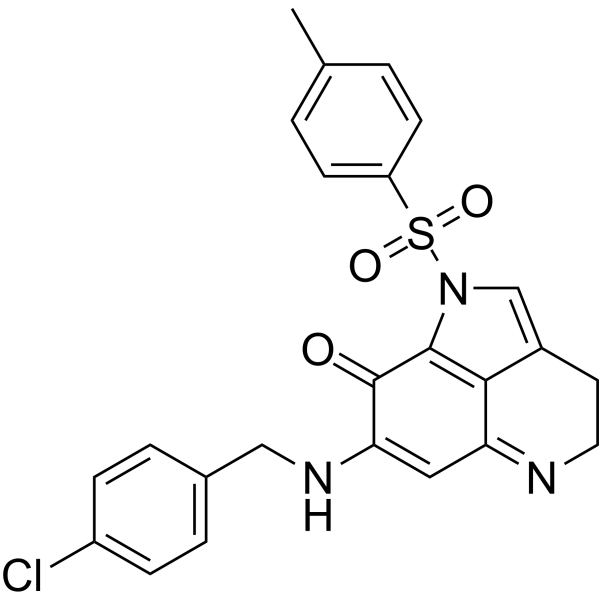| In Vitro |
MA242 (0.05-5 μM; 72 hours) free base significantly inhibits pancreatic cancer cell growth, with IC50s ranging from 0.1 to 0.4 μM, regardless of the p53 status of the cells. However, MA242 free base shows minimal effects on the growth of normal HPDE cells (IC50=5.81 μM), indicating that MA242 has selective effects against cancer cells[1]. MA242 (0.1-0.5 μM; 24 hours) free base significantly decreases the MDM2 and NFAT1 protein levels at a low concentration in all three cell lines[1]. MA242 free base decreases cell proliferation and induces apoptosis in pancreatic cancer cell lines regardless of p53 status[1]. MA242 free base alone or in combination with Gemcitabine inhibits pancreatic tumor growth and metastasis without any host toxicity[1]. MA242 free base exerts cytotoxicity against hepatocellular carcinoma (HCC) cells by inhibiting the NFAT1-MDM2 pathway in vitro, independent of p53. MA242 showed selective cytotoxicity against HCC cells, with IC50 values ranging from 0.1-0.31 μM[2]. Cell Viability Assay[1] Cell Line: The human pancreatic cancer HPAC, Panc-1, AsPC-1, Mia-Paca-2 and BxPC-3 cell lines; The human pancreatic ductal epithelium (HPDE) cell line Concentration: 0.05, 0.5, and 5 μM Incubation Time: 72 hours Result: The IC50s are 0.14, 0.14, 0.15, 0.25, 0.40, and 5.81 μM for Panc-1, Mia-Paca-2, AsPC-1, BxPC-3, HPAC, and HPDE cells, respectively. Western Blot Analysis[1] Cell Line: The human pancreatic cancer HPAC, Panc-1, and AsPC-1 cell lines Concentration: 0, 0.1, 0.2, and 0.5 μM Incubation Time: 24 hours Result: Decreased the expression of MDM2 and NFAT1.
|
| In Vivo |
MA242 (IP; 2.5, 5, 10 mg/kg) free base suppresses orthotopic pancreatic tumor growth in vivo, independent of p53[1]. There were no significant differences in the average body weights between the vehicle- and MA242 free base-treated mice in either of the models, did not have significant host toxicity at these effective doses[1]. Animal Model: Female 4-6-week-old athymic nude mice (nu/nu, 4-6 weeks) bearing AsPC-1-Luc or Panc-1-Luc tumor[1] Dosage: 2.5 or 5 mg/kg for Panc-1 tumor-bearing mice; 10 mg/kg for AsPC-1 tumor-bearing mice Administration: IP; 2.5 or 5 mg/kg/d, 5 d/wk for five weeks for Panc-1 tumor-bearing mice; IP; 10 mg/kg/d, 5 d/wk for three weeks for AsPC-1 tumor-bearing mice Result: Resulted in 56.1% and 82.5% inhibition of tumor growth in nude mice bearing Panc-1 orthotopic tumors, respectively. Significantly suppressed the growth of AsPC-1 orthotopic tumors by 89.5% (P < 0.01) compared with the tumors in control animals. Led to almost complete tumor regression in MD242-treated mice in both models.
|
